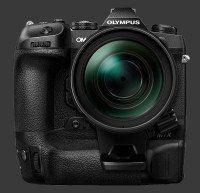Olympus OM-D E-M1X Review
Olympus OM-D E-M1X Usability - How easy is it to use?
Even though the Olympus E-M1X is the first dual-grip mirrorless digital camera with a new design, it certainly retains the Olympus DNA. Its controls are quite similar to other OM-D series and it will be familiar to users of their users. Coming from other brands, it will take some time to learn how to use this mirrorless efficiently.

The body of the E-M1X features two deep comfortable grips which make it easy to hold the camera securely in any orientation. This is a heavy camera which feels extremely sturdy except for the rotating LCD hinge which shows some flex. The rest seems built like a tank and it constructed to resist the elements with a IPX1-rated splashproof, dustproof and weatherproof body which can also handle temperatures down to -10C. As always, a weather-sealed lens is required for the whole thing to be stand adverse weather and there are quite a few weatherproof Micro Four-Thirds lenses. Every button and dial feels solid with good positive feedback.
Each grip features a standard two-stage shutter-release mounted at a 45° angle for comfort. These releases have a short travel and soft halfway point to minimize camera shake. A front control-dial is located below each release. They have good texture and firm detents, making them easy to use with gloves on while avoiding accidental changes. With the hand on either grip, two buttons customizable buttons fall below the fingers. These have a different feel so that they can be distinguished by touch alone. Note that there is no lock on the vertical shutter-release, so holding the camera too low can result in accidental shots.

Although similarly laid out to the E-M1, the top of the E-M1X is larger and accommodates a few more controls. The left shoulder has a larger elevated circle with three buttons. There are actually the only controls on the camera which are hard to press and so do not feel responsive. These support the following functions:
- Flash & Drive Mode: The front control-dial selects a Flash Mode, while the rear one a Drive Mode.
- Bracketing: While pressed, the front control-dial selects a parameter to bracket for and the rear control-dial selects bracketing increments.
- Metering & Focus: Use the front control-dial to cycle over metering modes and the rear for focus modes.
At the base of these buttons, there is a two-position rotating power-switch. It is very firm to prevent turning the camera on or off accidentally. Next to it, there is a viewfinder housing with a standard hot-shoe at the top. The housing covers the built-in GPS unit as there is no built-in flash.
A traditional Mode Dial is found to the right of the EVF. It offers the usual PASM modes plus a dedicated position for Bulb exposure. P supports Program Shift and B provides Live-Time and Live-Bulb modes. There are also 4 custom modes positions plus a dedicated Movie mode. This Mode Dial has nice detents and also features a locking button for added security but the dial is so good that it is not really needed.
Three circular buttons are found just behind the shutter-release. They are ordered very logically and are distinguishable by touch due to their different textures. The left most button controls Exposure-Compensation. It also allows to adjust the tone-curves for shadows, midtones and highlights separately by pressing the Info button on the back of the camera. Each curve can be adjusted ±7 steps. The central button allows the selection of the ISO sensitivity. The right button defaults to Video Record yet can be customized for use in Stills mode given that there is no point using it without entering Video mode to preview framing.

The standard grip side of the E-M1X becomes the top of the camera when shooting in portrait orientation. Naturally, it is quite flat. Near the usual top, there is a small rubber flap that covers the wired-remote connector. The dual memory-card compartment has a hard plastic door which is released by a lift-and-twist lever. This makes it impossible to accidentally open and compromise weather-sealing. A slightly recessed area contains the vertical EC and ISO buttons. There is no need for a Video Record button here, since video is always recorded horizontally. The left side of the camera has doors for many ports: stereo audio input, stereo audio output, Micro-HDMI and USB-C.
Right below, there is a twistable release to pull out the battery tray which holds two batteries. The camera drains them in sequence and only needs one to operate but the combined capacity give the E-M1X a battery-life of 870 shots-per-charge. The USB-C port supports charging of both batteries and there are LEDs on the back that indicate which battery is being charged. When both need power, they charge simultaneously.
Even though the Olympus OM-D E-M1X is a rather large mirrorless camera, its back is packed with controls. Starting at the top left corner, there is a button that toggles the rear LCD between viewing mode and a digital control panel display. When OK is pressed, the panel becomes interactive. Next to it, one finds an extra large and sharp 2.4 megapixels 0.5" EVF. It offers 0.83X magnification which is the largest viewfinder among anything small than Medium Format. The view is very crisp and refreshes quickly. This unit remains visible in low-light, unlike the one in the E-M1 Mark II. Exposure is simulated in Manual mode yet the EVF is not always Exposure-Priority and can be misleading in semi-automatic modes.

An Olympus classic lever with central button offers a huge amount of customization. The button itself can be set to any one of 33 functions, which are available to choose from for must customizable buttons. The lever has three modes of operation:
- Dial Switch: When set to 1, control-dials set Aperture and Shutter-Speed. When set to 2, the control-dials change ISO and WB.
- Focus Mode Switch: Toggles between two sets of focus configuration. This is customizable to include any of: Focus Mode, AF Selection Mode and AF Target.
- Stills-Video Switch: Toggles between Still and Video settings.
Further right, there is a customizable AE-L/AF-L button which can operate one of the same 33 functions as the Lever Button described above. Next to it is the rear control-dial. This is dial has nice and firm detents. A 3" Touchscreen LCD with 1 megapixels is mounted on a rotating hinge attached to the left side of the camera. The LCD is flexible enough to fold it reversed onto the camera to protect it. It does a similar view as the EVF, although much less precise due to the lower resolution.
Along the right edge of the LCD, there is an 8-way focus joystick to control the focusing target. An Info button below cycles over display modes which are customizable independently for stills, video and playback modes. That is a considerable amount of customization which allows users to make cycling over displayed information faster. Next to the Info button, there is a standard 4-way controller with central OK button. Right below it, there is a typical Playback button which works just as expected.
The upper AE-L/AF-L, rear control-dial and 8-way joystick are echoed for the vertical grip. These do exactly the same thing as there horizontal counterparts. Just below the right side of the LCD, there is a 3-position locking lever. In its upper position, it locks buttons for the vertical grip. In the default central position, all controls are fully operational. A final C-Lock position allows the user to customize which controls get locked.
Four buttons remain in a row halfway between the LCD and bottom of the camera: Menu, Delete, Card and WB. Delete is usable during Instant Review. Card switches between active memory-cards when two cards are inserted. WB allows any control-dial to cycle over white-balance options. The Menu button works exactly as usual.
Overall, the Olympus OM-D E-M1X has fantastic ergonomics. Its incredible amount of customization options make menus and setting overwhelming yet deliver the flexibility to make this camera work very efficiently. Buttons are logically placed and recognizable by touch which is crucial when operating in fast-paced environments. Even control-dials can be customized for each exposure mode which makes it possible to keep them useful at all times. ISO can be set by control-dial which is very useful. Buttons near both shutter-releases self-release and keep the camera mostly modeless except for the Function Lever and Mode-Dial. Only the button on the left shoulder are hard to press.
 |
Please Support Neocamera
All information on Neocamera is provided free of charge yet running this website is a huge endeavor. Purchases made via affiliate links found throughout the site help keep it running and up-to-date. There is no additional cost to you, so please consider buying via these links to our affilates:
If you found any information on this site valuable and did not purchase via our affiliate links, please considering donating via PayPal:
Any amount will be greatly appreaciated. Thank you for your support!
Olympus E-M1X Highlights

Sensor-Size: 17 x 13mm

Actual size when viewed at 100 DPI
| 20 Megapixels Mirrorless | ISO 64-25600 |
| Micro Four-Thirds Mount 2X FLM | Shutter 1/32000-60s |
| 5-Axis Built-in Stabilization, 7-Stop Improvement | Full manual controls, including Manual Focus |
| 0.50" Built-in EVF 2.4 Megapixels (0.83X) | Custom white-balance with 2 axis fine-tuning |
| Automatic Eye-Start sensor | Spot-Metering |
| 2 Axis Digital Level | Hot-Shoe & Sync-Port |
| Weatherproof down to -10C | Stereo audio input |
| Built-in Dust Reduction | Lithium-Ion Battery |
| 60 FPS Drive, 49 Images | Secure Digital Extended Capacity x 2 |
| 4096x2160 @ 24 FPS Video Recording | |
| 3" LCD 1 Megapixels |
Updates
2024.11.18

Best 2024 Photography Gifts for Every Budget
Great gifts for photographers and photo enthusiasts selected for every budget among the best products of 2024.
2024.08.07

Eye Protection Tips for Professional Photographers
The four main considerations for professional photographers regarding eyewear.
2024.07.14

Fujifilm X100VI Review
Flagship fixed-lens compact digital camera with a 40 MP sensor and Image-Stabilization, a first for the series. Retro design featuring dual control-dials, plus direct ISO, Shutter-Speed and EC dials. Its hybrid viewfinder can switch between EVF and OVF mode.
2024.05.09

Fujifilm GFX100 II Review
Flagship 102 Megapixels Medium-Format Mirrorless Digital Camera with 8-Stop 5-Axis IBIS, 8 FPS Drive, 8K Video and 400 MP Super-Resolution capture in a weatherproof and freezeproof body with dual control-dials and dual memory-card slots.
2024.04.03

Fujifilm X-T5 Review
Newest Fujifilm flagship boasting a 40 MP APS-C sensor, 5-axis IBIS with 7-stop efficiency, 15 FPS continuous drive, 6.2K Video capture, dual control-dials and dual SDXC UHS-II slots in a sturdy weatherproof and freezeproof body.
2023.11.20

Best Digital Cameras of 2023
Find out which are the Best Digital Cameras of 2023. All the new Mirrorless Digital Cameras from entry-level to high-end professional.
2023.07.10

Fujifilm X-H2 Review
40 Megapixels APS-C Hybrid Mirrorless Digital Camera with 7-stop IBIS. Fastest shutter ever and 8K video capture. Large builtin EVF with 0.8X magnification and 5.8 MP, plus an Eye-Start Sensor. Packed with features and large number of controls in a weatherproof and freezeproof body.
2023.05.07

Sony FE 20-70mm F/4G Review
Review of the unique Sony FE 20-70mm F/4G lens. The optical zoom of this lens spans ultra-wide-angle and medium focal-length coverage, making it one of the most versatile Full-Frame lenses on the market.
2023.01.15

Huion Inspiroy Dial 2 Review
Review of the Huion Inspiroy Dial 2 tablet, a medium sized drawing surface with dual dials and customizable buttons. Connects via USB-C or Bluetooth 5.0 with Windows, Linux and Android support.
2022.12.08

How to Pack for a Photo Trip
Find out how to pack for a travel photography trip, carry your gear safely while meeting airline regulations.
2022.11.13

Best Digital Cameras of 2022
The best digital cameras of 2022. A short list of the most outstanding models in their respective categories. Choose one for yourself or as a gift.
2022.09.21

Pentax DA* 60-250mm F/4 SDM Review
Review of the Pentax DA* 60-250mm F/4 SDM, the constant-aperture telephoto zoom with the highest zoom-ratio on the market.












